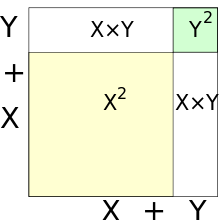Freshman's dream

The freshman's dream is a name sometimes given to the erroneous equation (x + y)n = xn + yn, where n is a real number (usually a positive integer greater than 1). Beginning students commonly make this error in computing the power of a sum of real numbers.[1][2] When n = 2, it is easy to see why this is incorrect: (x + y)2 can be correctly computed as x2 + 2xy + y2 using distributivity (or commonly known as the FOIL method). For larger positive integer values of n, the correct result is given by the binomial theorem.
The name "freshman's dream" also sometimes refers to the theorem that says that for a prime number p, if x and y are members of a commutative ring of characteristic p, then (x + y)p = xp + yp. In this case, the "mistake" actually gives the correct result, due to p dividing all the binomial coefficients save the first and the last.
Examples
- , but .
- does not generally equal . For example, , which does not equal 3+4=7. In this example, the error is being committed with the exponent n = 1⁄2.
Prime characteristic
When p is a prime number and x and y are members of a commutative ring of characteristic p, then (x + y)p = xp + yp. This can be seen by examining the prime factors of the binomial coefficients: the nth binomial coefficient is
The numerator is p factorial, which is divisible by p. However, when 0 < n < p, neither n! nor (p − n)! is divisible by p since all the terms are less than p and p is prime. Since a binomial coefficient is always an integer, the nth binomial coefficient is divisible by p and hence equal to 0 in the ring. We are left with the zeroth and pth coefficients, which both equal 1, yielding the desired equation.
Thus in characteristic p the freshman's dream is a valid identity. This result demonstrates that exponentiation by p produces an endomorphism, known as the Frobenius endomorphism of the ring.
The demand that the characteristic p be a prime number is central to the truth of the freshman's dream. In fact, a related theorem states that if a number n is prime then (x + 1)n ≡ xn + 1 (mod n) in the polynomial ring . This theorem is a direct consequence of Fermat's little theorem and it is a key fact in modern primality testing.[3]
History and alternate names
The history of the term "freshman's dream" is somewhat unclear. In a 1940 article on modular fields, Saunders Mac Lane quotes Stephen Kleene's remark that a knowledge of (a + b)2= a2 + b2 in a field of characteristic 2 would corrupt freshman students of algebra. This may be the first connection between "freshman" and binomial expansion in fields of positive characteristic.[4] Since then, authors of undergraduate algebra texts took note of the common error. The first actual attestation of the phrase "freshman's dream" seems to be in Hungerford's undergraduate algebra textbook (1974), where he quotes McBrien.[5] Alternative terms include "freshman exponentiation", used in Fraleigh (1998).[6] The term "freshman's dream" itself, in non-mathematical contexts, is recorded since the 19th century.[7]
Since the expansion of (x + y)n is correctly given by the binomial theorem, the freshman's dream is also known as the "Child's Binomial Theorem" [3] or "Schoolboy Binomial Theorem".
See also
References
- ↑ Julio R. Bastida, Field Extensions and Galois Theory, Addison-Wesley Publishing Company, 1984, p.8.
- ↑ Fraleigh, John B., A First Course in Abstract Algebra, Addison-Wesley Publishing Company, 1993, p.453, ISBN 0-201-53467-3.
- 1 2 A. Granville, It Is Easy To Determine Whether A Given Integer Is Prime, Bull. of the AMS, Volume 42, Number 1 (Sep. 2004), Pages 3–38.
- ↑ Colin R. Fletcher, Review of Selected papers on algebra, edited by Susan Montgomery, Elizabeth W. Ralston and others. Pp xv, 537. 1977. ISBN 0-88385-203-9 (Mathematical Association of America), The Mathematical Gazette, Vol. 62, No. 421 (Oct., 1978), The Mathematical Association. p. 221.
- ↑ Thomas W. Hungerford, Algebra, Springer, 1974, p. 121; also in Abstract Algebra: An Introduction, 2nd edition. Brooks Cole, July 12, 1996, p. 366.
- ↑ John B. Fraleigh, A First Course In Abstract Algebra, 6th edition, Addison-Wesley, 1998. pp. 262 and 438.
- ↑ Google books 1800–1900 search for "freshman's dream": Bentley's miscellany, Volume 26, p. 176, 1849
